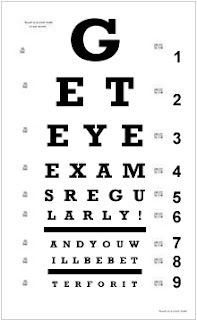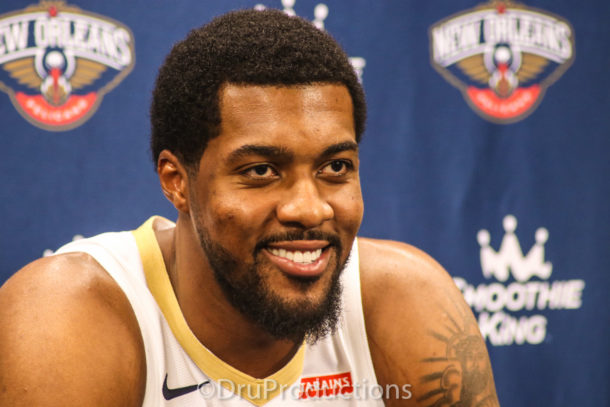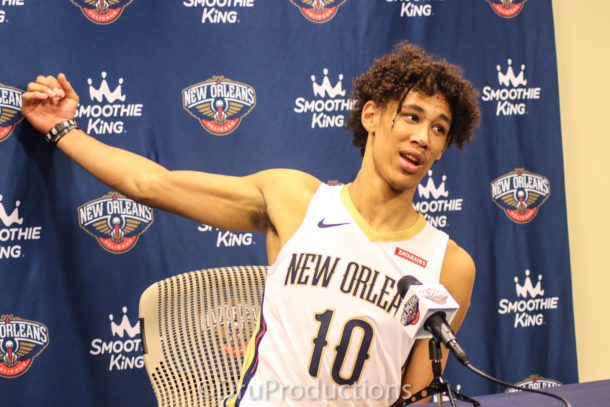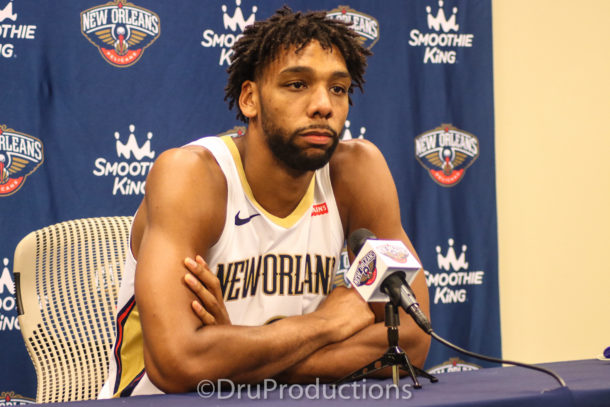« An Eye Test Evaluation After a Handful of Games – Part 1
Early Season Eye Test Part Two — The Bigs

As we continue to forgo the urge to look at the stats, and instead focus on what our eyes are telling us, I turn my attention to the bigs. Unfortunately, we have yet to see a regular season minute from the most important big man, but we have had opportunities to see a decent amount from all 3 of the centers vying to be the guy who can fit next to Zion for the next few years.
Gentry’s system can work with several different types of bigs, as we have seen stretch bigs like Channing Frye thrive, lob bigs like DeAndre Jordan, slow footed bigs like Robin Lopez, and ultra athletic small ball centers like Amare Stoudamire. The question is – Which one of these bigs, if any, will thrive in lineups with Zion and Ingram next to them?

Derrick Favors probably has less than 100 fully healthy minutes under his belt as a Pelican. He has been banged up since the preseason started and he finds himself on the injured list yet again after hurting his back in the Miami game. But when he was healthy, we saw a steady presence capable of controlling the boards on both ends. He does it purely with the room he carves out with his steady base and his intelligence. At best, he is an average athlete for the position and he isn’t going to rebound a ton out of his area or erase a ton of shots from the weak side.
Offensively, he is going to set a solid screen and move to areas in the paint where you have an open lane to make a bounce pass. From there, he can finish with touch and knock down his free throws if he is fouled. What he won’t do is go up and get lobs from your guards. And that vertical spacing puts a lot of pressure on a defense, which can open up space for shooters. However, the thing I have been pleasantly surprised by is his vision and passing skills off the short roll. Again, I don’t look at the stats for this piece (intentionally), but I would bet that he has more assists per minute from the paint than Lonzo Ball.
How He Fits With A Healthy Pelicans Team
Derrick Favors starts against almost every team, but shouldn’t finish against more than 3 or 4. At the beginning of games, he offers a steadying presence on defense and the glass while giving the Pelicans a chance to get the guards open by setting good screens in the pick and roll. But to close games, his below average perimeter defense leaves him susceptible to smaller units, without the ability to punish them enough on the other end to make it a net neutral.
Late in games, the Pelicans will go to Jrue, Ingram, and/or Zion meaning that the other two players need to either provide spacing on offense or switch ability on defense. Ideally, they provide both. Favors provides neither of those things, so unless you are playing a team that is going to the low or mid post for their offense in critical possessions, Favors should be off the floor.
What Favors should do is give a healthy Pelicans team 25-30 minutes per night, depending on the matchup. He should be on the floor with quality guards who can hit him on the short roll and who can utilize his screens to get off great shots. NAW would fit well with him, and he seems to have a chemistry with Lonzo in the very, very short minutes they have shared the court together.
He will likely hurt the space for Zion on offense, but help cover up his mistakes on defense, so it is a bit of a wash. Still, I’d probably prefer Favors to get a lot of his minutes with Melli or Kenrich at the 4 next to him. I’d be interested in seeing a lineup of Lonzo-NAW-Hart-Melli-Favors, with Favors in the pick and roll with any of the guards while the other 3 players space. I think that lineup could be good enough defensively, mostly because I think it could dominate the boards.
How He Fits Long Term
Anybody manning the 5 position now is just holding a spot for Jaxson Hayes, who has shown enough already to make it safe to assume he will be a good to great starter in this league at some point. The question is – How long will it take Hayes to develop and what kind of minutes can he handle on the path to reaching his prime?
History says that Hayes likely won’t be a winning player for at least 2-3 more years. Some may point to a guy like Capela, who was starting for a really good team in his 3rd season, but Capela and even Deandre Jordan (another comparison), had all time great facilitators making the game incredibly easy for them. Hayes won’t have that.
Tyson Chandler, who had a similar build and athleticism coming out, struggled for his first five years until he was partnered with Chris Paul – who again, made the game incredibly easy for a bouncy big. Hayes will take years to learn how to set a good screen, to get positioned properly on defense, to make the right rotations, to develop the strength in his lower body to maintain position, etc. Right now, he is just getting by off effort and raw talent. And without an elite playmaker to amplify those traits, he will likely be a small negative until he develops a more cerebral game.
Yes, I know this is about Favors, but that was all necessary to understand what the Pelicans need in the next few years from the center position and what they can afford to spend on that position. I think it would be safe to assume that Hayes doesn’t crack the 25mpg threshold until year 4 at the earliest. If you add in Zion likely getting 6-8 mins at the center position, much like Draymond did his first few years, then you have anywhere between 15-25 minutes per game available at the center position to give to a stable presence.
That presence could be Favors, but the cost is going to determine that every bit as much as the production. If what you are looking for is a 22mpg center to be a starter who doesn’t finish, then would it make sense to pay 15+ million dollars per year to that guy, just as Ingram, Jrue, Lonzo, and Hart are about to get new deals?
What the Pelicans are looking for is something similar to what Aron Baynes (5.4 mil) is giving Phoenix, or Zubac (6.4 mil) is giving the Clippers, or Kanter (4.8 mil) is giving the Celtics. Yes, you could argue that there are some quality centers getting paid what Favors makes and even more, who don’t play close to 30 minutes a game. But those guys are on win now teams and/or are on the final year of their deal and won’t get anything close to that next year.
For the Pelicans, Favors (or someone like him) is incredibly necessary for the next 2-3 years, as Hayes blossoms. But the question is: How much financial flexibility is worth giving up for a guy who might only be 5-10% better than the guys you can get on a 1 year deal for 1/3rd the price? And could you even make the argument that you would prefer the inferior player because it would make your coaches decision easy to give more minutes to Hayes? We all know that coaches lean on vets, but if that vet is Bismack Biyombo, as opposed to Derrick Favors, your coach is likely to play Jaxson Hayes more often.
It’s all an interesting thought experiment. Personally, I would have a 2 year, 32 million dollar contract ready for Favors to sign in July. And I could even go a little higher on the annual salary if it comes to it, but I will not budge on the years. If he walks, I wouldn’t be happy, but I know I could use that same money to patch together a solid center rotation, and I smile when nobody is looking because this means more minutes for Hayes and even more minutes for Zion at the 5.

When Griffin drafted Hayes, he did so with the idea that this would be a redshirt year for Hayes. But Hayes has looked impressive enough to warrant minutes, and that was before the rash of injuries. The other worldly athletic skills are obvious to any observer, but my guess is that his desire to soak up knowledge is the reason why coaches want to get him on the floor. Yes, he is a deer in the headlights at times out there, but he is eager to learn about the highway, different models of cars, and the capabilities of his hooves so that he can be prepared for his next venture into the NBA paint.
The biggest worry, both short term and long term, is the lack of lower body foundation necessary to get the position he wants. Not only for rebounds, but for sealing defenders who front him, for setting solid screens, and for low post defense. This is also the reason it seems like he is far more explosive when he gets a running start and on his first jump. To be an elite defender long term, he will have to create a wall going vertical – off standing still – and he will also have to win possessions off multiple jumps.
The biggest reason for optimism long term is his hands and touch around the rim. Some guys have his height, and a few of them have his athleticism too, but very few have that and soft hands that can produce put backs and bank shots when the situation doesn’t allow you to just throw it down viciously. He also has touch when moving at full speed, which is also very rare for a big. In the Portland game, there was a play where he was streaking down the middle of the lane and actually received the ball too late, yet he was able to lay it up going full speed, with his body already under the basket. That is simply not normal.
How He Fits With a Healthy Pelicans Team
Hayes has already shown enough to warrant minutes, even when the entire roster is available to suit up. He might not be a better player than Jahlil Okafor, but his skill sets are more needed on this team than Jah’s. Aside from maybe Ingram in certain situations, there isn’t a single other player on this roster who makes an opponent think twice about going to the basket. And no player other than Zion scares opponents as a lob threa. We saw that threat scare Whiteside a couple of times the other night, opening up lanes for the guards.
What you need to do when Hayes is on the court is have additional length and rebounding around him. He will get bullied by bigger centers, so you need a guy like Kenrich Williams who can help double, and then recover out to shooters. I would keep guys like Frank Jackson and E’Twaun Moore out of lineups with Hayes, for instance.
Offensively, he and NAW seem to have a bit of a chemistry, and Melli can actually play next to him on offense, while Hayes takes the more agile big on the other end. A bench unit that could work would include Hayes and either Williams or Melli at the 4, then NAW, Lonzo, and Hart on the perimeter. Or you could go really big and play two of NAW, Lonzo, Hart at guard and put Williams, Melli, and Hayes up front.
Either way, playing Hayes isn’t all about the future. His energy and skill set actually give the Pelicans the best chance to win now, as long as its in the right lineups and you are not asking him to defend brilliant centers who will pump fake him to death like a Jokic or monsters who will draw a foul on him every possession like Embiid.
How He Fits Long Term
The conventional wisdom is that Zion would work best with a stretch 5, but vertical spacing is a real thing too. Yes, Zion barreling down an open lane, with the ability to kick to shooters when help comes is a good thing, but Hayes can provide a lob threat in that same situation and you would need to shoot over 65% on open 3’s to be more efficient than the 98% Hayes is going to shoot on ally oop lobs from Zion.
Defensively, the IQ needs a lot of work before he can be a starter and finisher for an elite team. He doesn’t seem to trust his length and quickness, but once he does, he won’t bite nearly as much on pump fakes. He will go up vertical more often (like he did against Melo), instead of flailing his arms as hard as he can, trying to block anything and everything.
This is the NBA, though, and the idea that he will be the starting and finishing 5 in every matchup might be a little naive. Even if he becomes prime Tyson Chandler with a mid range jumper, there will be guards too quick for him to stay with on the perimeter. There will also be times when the Pelicans need to draw an Embiid out of the paint, and a stretch 5 will be more useful.
Looking at Bam Adebayo as a template makes some sense. Adebayo is fantastic, but even he only gets 32 mpg, and is often replaced by Olynyk or Leonard when the Heat need to pull an opposing big out of the paint. Adebayo is ultra efficient as a low usage big, but on those nights where the Heat have a few guys banged up or the matchup is right, you can get 20-25 points out of him without asking him to do things he can’t do. For Hayes to get there, he needs to put on about 25 pounds over the next 2-3 years, without losing much of the explosiveness that makes him unique. If he does that, the Pelicans could be looking at the best front court in the league for the majority of the 2020’s.

Jahlil Okafor has been a pleasant surprise from an offensive perspective this year, going so far as to outduel Nikola Jokic in the Pelicans first win of the season. When he takes his time and can drive right or shoot over his left shoulder in the post, things usually end well. But too often he will drive into the teeth of the defense, get stopped and then take an ill advised shot anyway. Although I will put some of the blame on his teammates, who seem to assume that Okafor is going to hoist a shot whenever they get him the ball, so they don’t move.
On defense, there aren’t many good things to say besides the standard backhanded compliment of “at least he tries.” And he does give effort on that end, but his feet aren’t quick enough to help on the perimeter, nor does he do even an adequate job of protecting the rim. On another team, with more continuity and/or better individual defenders, you might be able to overcome Jahlil’s glaring weaknesses. But on this team, he is destined to be a net negative because the things he provides, the Pelicans don’t really need and the things the Pelicans need, Okafor can not provide.
How He Fits With A Healthy Pelicans Team
Jahlil Okafor is the bullpen pitcher you have in order to deal with 4-5 specific batters a year. When Jokic comes to town, Okafor makes some sense. Enes Kanter, Brook Lopez, Marc Gasol, and Andre Drummond are examples of guys I’d rather put Okafor on that Hayes or Melli. He should be able to both negate some of their advantages on offense while attacking their deficiencies on the defensive end.
But outside of specific opponents, Okafor should stay firmly planted to the bench when the Pelicans are healthy. He doesn’t make his teammates better on the offensive end, and he leaves them far too exposed on the defensive end. Maybe Okafor would be a net positive on a 2nd unit filled with defensive minded athletes who can limit points on that end while Okafor goes to work on the offensive end. But that is not this Pelicans roster. At least not when it is fully healthy.
How He Fits Long Term
The Pelicans have their center of the future on the roster, and their center of the next 1-2 years needs to provide things that are simply not in Okafor’s wheelhouse. Okafor has shown enough to prove that he belongs in this league, and he should have suitors when he hits free agency next year. But the Pelicans should not be one of those suitors.
The best case scenario is that Jahlil helps get the Pelicans get a few more wins in the right matchups, like he did against Denver. Or maybe he can get the Pelicans a nice 2nd round pick and/or a decent prospect at another position. But beyond that, nothing else should be expected from Okafor long term with this franchise.
Keep up with the entire eye test series here




